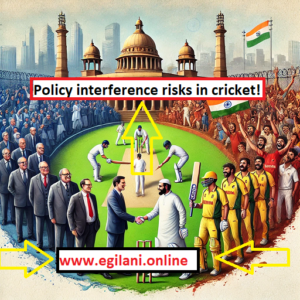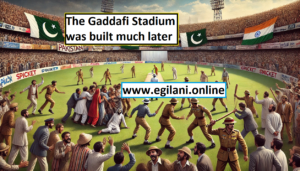Introduction
It wasn’t too long ago—back in 1996—when Pakistan, India, and Sri Lanka collectively hosted the Cricket World Cup in South Asia. Today, however, the Indian cricket team refuses to play in Pakistan and has chosen to play all its Champions Trophy matches in Dubai. On the one hand, Indian cricketers are reluctant to visit Pakistan, but on the other hand, numerous Indian sports journalists have obtained visas under the pretext of covering the Champions Trophy and have arrived in Pakistan. The editor of a major Indian newspaper sent me a message requesting me to arrange an interview with Babar Azam for their sports reporter, who was visiting Pakistan.
I requested from the respected editor why they had sent their reporter when their very own cricket team became unwilling to visit. He responded, “Brother, forget about this stuff! Pakistan is a big product—it sells nicely in Indian politics, the movie industry, and even in cricket.”
Presently, a debate is ongoing in India approximately how, no matter refusing to play in Pakistan and barring Indian cricketers from collaborating inside the PSL, international cricket in Pakistan has no longer been stopped.
In fact, the Champions Trophy is being held there today.
The editor further mentioned that they had sent their reporter to cover a feature story on the real reason behind Pakistan’s cricketing success.

The Indian sports journalists covering the Champions Trophy may write whatever they wish, but if you truly want to understand the difference between Pakistan and India, just analyze their cricket systems—it will become clear. most people of humans in both countries are passionately passionate about the game. This passion dates returned to a pre-partition event played in Bombay (Mumbai), Karachi, Madras (Chennai), and Calcutta (Kolkata). The event featured four groups: Hindus, Muslims, Parsis, and Europeans. Later, in 1937, a joint team of Christians, Sikhs, and Jews was introduced, bringing the total to five teams.
The tournament was called the Bombay Pentangular, and whenever the Muslim team won, Quaid-e-Azam would send a congratulatory message. When Mahatma Gandhi realized that the Bombay Pentangular was giving prominence to the All India Muslim League’s Two-Nation Theory, he began opposing the tournament. In 1934 and 1935, the Muslim team defeated the Hindu team in this tournament, causing an uproar. The key player in these victories was Wazir Ali, while the opposing team had notable players like C.K. Nayudu.
In 1940, the Congress Party prohibited Hindu players from competing against Muslims, leading to the Hindu team’s withdrawal from the Bombay Pentangular. However, the tournament continued, and the Muslim team won once again. Eventually, the Hindu team rejoined, but in 1944, they lost the final to the Muslims. This was an era when cricket was not yet a popular public sport, but it still held great significance.
In 2013, Pakistan’s former Foreign Secretary and PCB Chairman, Shaharyar Khan, wrote a book titled Cricket Cauldron, with its foreword penned by Imran Khan. For the first time, the book highlighted cricket’s role in the Pakistan Movement.
After Pakistan and India gained independence in 1947, the first-ever Pak-India cricket series took place in 1952, four years after the 1948 war between the two countries.
The 1954–55 Pakistan vs. India test collection was a historical cricketing occasion that strengthened the wearing rivalry between the 2nd international countries. This became the primary time India toured Pakistan for a full test series, making it a historic second in cricket history. The tour included 5 take a look at fits, performed in diverse cities across Pakistan.
Explain in Detail
One of the most amazing elements of this series became the overwhelming guide for Indian fans. More than 10,000 Indian spectators were granted visas to tour to Pakistan, a testament to the passion and cricketing spirit that united each international location no matter political tensions. The fits attracted massive crowds, highlighting the shared ardor for the sport.
At that time, Lahore lacked a first-rate cricket stadium. Therefore, the check-in shape in Lahore became played at the historic Bagh-e-Jinnah floor, which had a rich legacy of hosting important cricket suits because of the British colonial technology. The ground, nestled inside the picturesque Lawrence Gardens, was a widespread cricket venue before the development of present-day stadiums like Gaddafi Stadium.
The suits had been performed on matting wickets as opposed to turf pitches, a commonplace exercise inside the subcontinent throughout that technology. The sluggish, turning pitches examined the batting and bowling competencies of each group. The collection itself became hard-fought and ended in a zero-zero draw, with all five fits ensuing in attracts.
This series laid the foundation for destiny cricketing ties between India and Pakistan, fostering a competitive but respectful courting that continues to these days.
The Gaddafi Stadium was built much later.
Few people know that the longest deadlock in Pakistan-India cricket history lasted from 1961 to 1978—for 17 years, the two nations did not play against each other.

In 1978, on the request of General Zia-ul-Haq, Indian Prime Minister Morarji Desai sent the Indian cricket team to Pakistan. However, during the matches, slogans demanding Bhutto’s release erupted. At a Lahore match, Begum Nusrat Bhutto led a protest for her husband’s freedom and was subjected to police baton charges. General Zia used cricket to divert political attention, while the Pakistan People’s Party (PPP) used cricket matches as a platform to campaign for Bhutto’s release.
Despite the resumption of cricket ties, relations between the two nations remained tense. In 1984, India quietly occupied Siachen Glacier, and while Pakistan and India were together in the 1996 World Cup, the Kargil War broke out in 1999.
During Pervez Musharraf’s tenure, cricket was used to improve diplomatic ties between the two nations, but the lack of trust-building with Kashmiris resulted in no significant breakthrough. The backlash to this cricket diplomacy came in the form of the 2008 Mumbai attacks.
The reaction to those attacks became the 2009 terrorist attack at the Sri Lankan cricket team in Lahore, which India used as a justification to boycott cricket in Pakistan. This boycott created demanding situations for Pakistan, however ultimately, after 29 years, hosting the Champions Trophy in Pakistan marks a chief defeat for India in cricket international relations.
India has one of the strongest international cricket systems, with regional associations organizing tournaments from school and college levels to university competitions. A structured club cricket system ensures a steady supply of talented players. In contrast, Pakistan lacks a stable cricketing infrastructure—whenever a new government takes over, Pakistan Cricket Board (PCB) policies change entirely.
these days, Pakistan’s cricket survives entirely because of its passionate players—folks that combat thru nepotism and favoritism, overcoming barriers through sheer determination and resilience. alas, their difficult paintings and sacrifices are often exploited via influential figures who promote their achievements for personal gains.
The story of Pakistani cricket is essentially the story of Pakistan’s flawed system—one where Babar Azam was denied a spot in his own Lahore team, forcing him to play for Islamabad. However, once he became a superstar, Lahore was quick to claim all the credit.
The Struggles of Pakistani Cricket: Passion vs. Systemic Flaws
Cricket in Pakistan has usually been greater than handiest a handy recreation; it’s an emotion, a passion, and for lots, a dream. but, under the surface of exciting matches and international beauty skills lies a machine riddled with nepotism, favoritism, and personal agendas.at the same time as dedicated gamers strive to make a call for themselves through sheer difficult work, their fulfillment is frequently exploited by means of influential figures for private advantage.
Nepotism and Favoritism in choice
considered one of the biggest demanding situations faced by way of aspiring cricketers in Pakistan is the unfair choice technique. talent on my own is rarely enough to cozy a gap inside the group. Connections, political affiliations, and personal relationships often outweigh benefit. Many professional gamers are both disregarded or pressured to fight an uphill war just to get noticed.
Babar Azam: A victim of the device
Babar Azam, now one of the excellent batsmen inside the international, faced rejection in his own place of origin, Lahore. regardless of his colossal skills, he turned into denied an area within the Lahore group and had to seek possibilities in Islamabad. This incident is a stark reminder of how even the most talented players should battle against an unfair system. paradoxically, as soon as Babar carried out international fulfillment, Lahore changed into brief to say credit for his upward push, dismissing the limitations he had to triumph over.
Exploiting players for non-public gain
The fulfillment of Pakistani cricketers often comes at a price. Their hard work is often used as a stepping stone for officers, coaches, and board participants who take credit for his or her achievements. This no longer most effectively demoralizes players but also discourages younger talent from pursuing the sport.
The need for change
For Pakistan to reclaim its lost cricketing glory, an obvious and benefit-based selection manner is vital. Players have to be given equal possibilities based on expertise, not connections. Without reform, the game will continue to go through, and future generations of cricketing legends might also way get the recognition they deserve.
